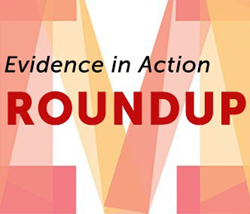Join us for our latest stroll through the Evidence in Action team’s blog feed. Reminder: Inclusion in the roundup is not an endorsement—it’s simply food for thought.
The federal Commission on Evidence-Based Policymaking is exploring ideas for how to increase the use of government data to inform the development and evaluation of public programs. Former White House adviser Quentin Palfrey, who now directs MIT’s poverty research group J-PAL North America, prescribes steps for the commission to follow.
Analyzing administrative data to adjust government programs may seem like dry, behind-the-scenes work, but when scaled up to redirect national policies, it can have a significant impact on millions of Americans.
Measuring Principal Performance Is Hard - But We Need to Try (Ed Impact blog)
Mathematica Senior Fellow Brian Gill explores a daunting question for education researchers and decision makers: How do we distinguish good principals from bad ones?
It is hardly surprising that it is difficult to assess principals’ professional performance, because their jobs are so highly varied. Unlike classroom teaching, effective school leadership constitutes a wide range of tasks that are not easily observed. It is not obvious what a superintendent should attempt to observe in order to gauge the
effectiveness of a principal’s leadership. Even so, despite the knotty problems associated with measuring principals’ professional practices and their contributions to
student achievement, the situation is not hopeless.
Systematic research reviews help policymakers and practitioners use evidence more effectively in their decision making. How do researchers ensure that their work is reflected in these important reviews? World Bank Senior Economist David Evans explains.
As anyone who has ever attempted to do a systematic review will know, getting key information from included studies can often be like looking for a needle in a haystack. Sometimes this is because the information is simply not provided, and other times it is because of unclear reporting. As a result, researchers spend a long time trying to get the necessary data.
Public Health 3.0: A Blueprint for the Future of Public Health (Health Affairs blog)
Karen DeSalvo, acting assistant secretary for health at the U.S. Department of Health and Human Services, and Georges Benjamin, executive director of the American Public Health Association, look at the evolution of public health in the United States and key steps for improvement.
The consequence of a crumbling public health infrastructure is often felt most intensely
in the communities with the greatest need. Research shows that for someone
who is at the bottom of income distribution, the zip code in which he or she lives
can mean a difference of 4.5 years in life expectancy. … On the other hand, many
communities have risen up to meet these challenges by pioneering, innovating, and transforming on the front lines to address the full range of factors that influence
a person’s health—from good schools to safe environments, stable housing to transportation, economic development to access to healthy foods.
Researchers and practitioners can, and must, do a better job of forging partnerships based on communication and trust to achieve their shared goal of serving the public good—according to three authors representing the foundation and research sectors.
Research-practice partnerships are not the path for the faint of heart. But acknowledging and addressing the challenges inherent in the work can bring about opportunities to close the notorious gaps between research and practice—to build two-way streets that improve work on both sides of the divide.
Revolutionizing the Collection of Household Data (International Food Policy Research Institute blog)
Looking at a study involving farmers in Bangladesh, researcher Patrick Ward discusses the challenges and opportunities of using smartphones to collect information from people in rural communities around the world.
One of the most pressing concerns in the short run is that smartphone adoption is likely to be concentrated among relatively young, relatively wealthy, and relatively well-educated members of society. Such participants will almost certainly be systematically distinct from the underlying population of interest, introducing an important source of bias. This can at least partially be ameliorated in the near term by crowdsourcing data (i.e., tasking participants to gather information from friends, family, and other members of their networks).


